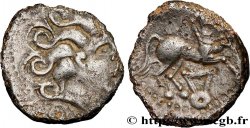v61_0350 - GALLIA - GALLIA DELLO SETTENTRIONALE - ÆDUI (BIBRACTE, Regione dello Mont-Beuvray) Quart de statère en électrum à la lyre, type de Chenôves
MONNAIES 61 (2014)
起拍价 : 500.00 €
估价 : 750.00 €
未售出的物品
起拍价 : 500.00 €
估价 : 750.00 €
未售出的物品
种类 Quart de statère en électrum à la lyre, type de Chenôves
日期: c. 70-50 AC.
铸币厂名称/城市 Autun (71)
材质 electrum
直径 12 mm
模子方针 3 h.
重量 1,75 g.
稀少度 R2
关于品相的说明
Belle petite monnaie, sur un flan un peu court et épais, en or très pâle. Droit et revers complets, avec une belle tête assez bien venue mais un revers un peu plus confus avec de petits défauts de métal assez superficiels. Fine patine grise
家谱
C’est le n° 434 de MONNAIES 57
正面
正面的文字 ANÉPIGRAPHE.
正面的说明书 Tête humaine laurée à droite, la chevelure stylisée ; grènetis.
背面
背面的文字 ANÉPIGRAPHE.
背面的说明书 Cheval galopant à droite ; au-dessus du cheval, l'aurige ; lyre sous le cheval.
评论
Ces monnaies du type de Chenôves se divisent en trois types ; à la lyre (classe I), à la rouelle (classe II) ou au triskèle (classe III).
Cet exemplaire présente un revers classique pour cette série mais un avers d’un style très inhabituel, traité en très haut relief ! Au revers l’aurige aviforme est très net en bord de flan. Alors que certaines monnaies sont plus jaunes ou orangées, cet exemplaire est en or presque blanc.
Cet exemplaire présente un revers classique pour cette série mais un avers d’un style très inhabituel, traité en très haut relief ! Au revers l’aurige aviforme est très net en bord de flan. Alors que certaines monnaies sont plus jaunes ou orangées, cet exemplaire est en or presque blanc.








 对产品描述纠错
对产品描述纠错 打印
打印 分享我的选择
分享我的选择 提问
提问 Consign / sell
Consign / sell
 产品介绍
产品介绍









